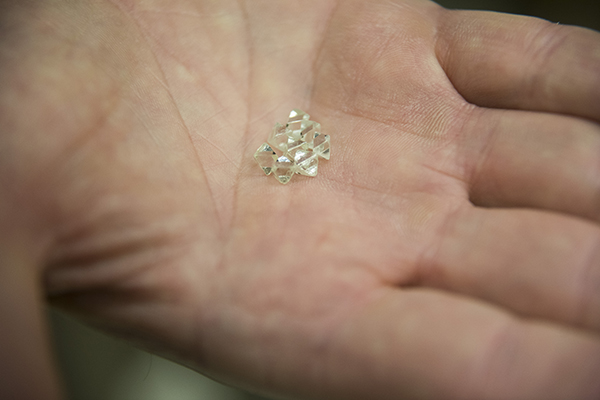
Graham Pearson (centre), Canada Excellence Research Chair in Arctic Resources, is leading the new Diamond Exploration Research and Training School out of the University of Alberta.
From their long-held appeal as jewelry to increasing industrial applications, there is nothing more symbolic of strength and endurance than diamonds. There is also no denying the strength of Canada's roughly $2-billion annual diamond industry. With two of three Canadian mines in their final phases of production, the time is now to source new exploration sites to ensure Canada remains at the forefront of the industry.
To help train and produce the next generation of highly qualified diamond explorers, the Natural Sciences and Engineering Research Council (NSERC) has announced an investment of $1.65 million over the next six years to a new Diamond Exploration Research and Training School (DERTS), led by the University of Alberta and with partners at the University of British Columbia.
"We are directly aligning our research with industry needs. It is essential that new graduates are able to move seamlessly into industry."-Graham Pearson
"There is a desperate need to sustain more discoveries if Canada is going to maintain its position as the world's number three diamond producer by value," says Graham Pearson, principal investigator of DERTS and Canada Excellence Research Chair in Arctic Resources at the U of A. "Diamond mining has put hundreds of millions of dollars into the economy of the North. That economic investment and momentum needs to be sustained going forward in the long term. The discovery of new deposits will be technologically challenging, so we are creating the next generation of industry-ready geoscientists."
Funded through NSERC's Collaborative Research and Training Experience Program (CREATE), DERTS includes industrial collaborations with 10 partners-including heavy-hitters De Beers, Diavik Mines, and Dominion Diamond Ekati Corporation-all committed to working with students on prospecting new mines. "We are directly aligning our research with industry needs," says Pearson. "It is essential that new graduates are able to move seamlessly into industry."
This transition will be facilitated with annual industrial internships, field work and community engagement in the Canadian Arctic, "soft-skills" training, and access to some of the finest research facilities in the world, with training and mentorship by world leaders in diamond research and exploration.

In addition to being a major boon to Canada's economy, diamond mining is one of the environmentally cleanest forms of mining, making it one of the best options for mineral extraction while leaving a minimal footprint on the North.
Situated in the "Gateway to Canada's North" with arguably the world's largest assembly of highly specialized diamond research equipment, the U of A-long known for its strength in diamond-related research-is the ideal leader for the new diamond exploration program. "We are uniquely positioned to provide very broad-ranging, highly specialized training," says Pearson of the calibre of faculty and program staff.
"We have a large group of specialist research staff focused on diamond exploration who are very complementary to each other. We have also partnered with researchers at UBC, meaning we have a team that covers all areas of diamond research." Eight U of A faculty members plus two from UBC round out the research areas of kimberlite volcanology, geochronology, geophysics modelling, remote sensing, and experimental mineralogy and petrology.
Launching in September 2016, DERTS will annually host 15 fully-funded students to engage in research related to diamonds and diamond exploration. Pearson says he and his colleagues are recruiting students from across Canada and around the world who are not only academically strong but also innately curious about diamonds and the world beneath our feet-a passion he shares.
"There's a specialness attributed to diamonds. For me, beyond the scientific interest and physical attraction, the biggest part of the appeal of diamonds is the unique time capsule they offer. Diamonds have been forming throughout Earth's history, and they give us this unique window to the deep Earth that's available in no other way."
Pearson hopes that, in addition to strengthening Canada's industrial longevity, this new graduate program ensures that people everywhere continue to have access to these enduring symbols.